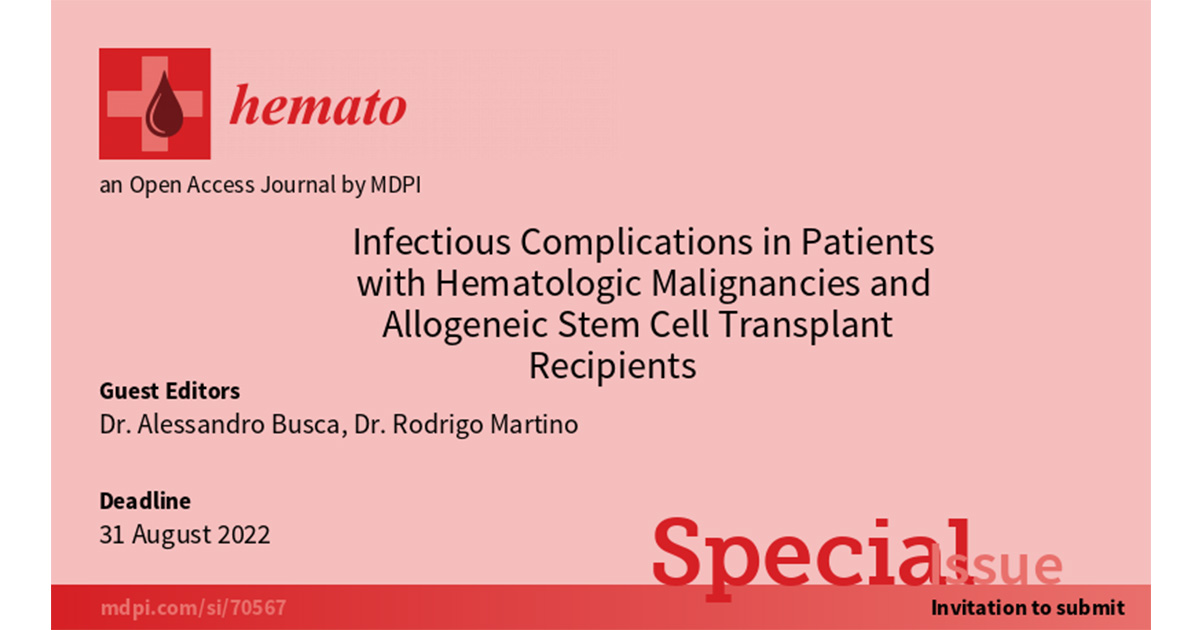- 1.0Impact Factor
- 2.0CiteScore
- 22 daysTime to First Decision
Infectious Complications in Patients with Hematologic Malignancies and Allogeneic Stem Cell Transplant Recipients
Special Issue Information
Dear Colleagues,
Over the last 10 to 15 years, the treatment options for patients with hematologic malignancies have seen the blossom of a large number of new agents and new therapeutic strategies like cellular therapies.
Despite achieving remarkable improvements in the management of patients with malignant hematologic disorders, infectious complications still represent a leading cause of morbidity and mortality, thereby limiting the effectiveness of curative strategies.
In this respect, knowledge of the epidemiology and risk factors of infectious complications as well as of the available therapeutic armamentarium may represent a tool of paramount importance to optimize the treatment of hematologic patients.
The aim of this Special Issue is to summarize the current data on bacterial, fungal, and viral infections in hematologic patients, providing the reader with a guide to design an appropriate therapeutic approach to the prophylaxis and treatment of infectious complications.
Dr. Alessandro Busca
Dr. Rodrigo Martino
Guest Editors
Manuscript Submission Information
Manuscripts should be submitted online at www.mdpi.com by registering and logging in to this website. Once you are registered, click here to go to the submission form. Manuscripts can be submitted until the deadline. All submissions that pass pre-check are peer-reviewed. Accepted papers will be published continuously in the journal (as soon as accepted) and will be listed together on the special issue website. Research articles, review articles as well as short communications are invited. For planned papers, a title and short abstract (about 250 words) can be sent to the Editorial Office for assessment.
Submitted manuscripts should not have been published previously, nor be under consideration for publication elsewhere (except conference proceedings papers). All manuscripts are thoroughly refereed through a single-blind peer-review process. A guide for authors and other relevant information for submission of manuscripts is available on the Instructions for Authors page. Hemato is an international peer-reviewed open access quarterly journal published by MDPI.
Please visit the Instructions for Authors page before submitting a manuscript. The Article Processing Charge (APC) for publication in this open access journal is 1200 CHF (Swiss Francs). Submitted papers should be well formatted and use good English. Authors may use MDPI's English editing service prior to publication or during author revisions.

Benefits of Publishing in a Special Issue
- Ease of navigation: Grouping papers by topic helps scholars navigate broad scope journals more efficiently.
- Greater discoverability: Special Issues support the reach and impact of scientific research. Articles in Special Issues are more discoverable and cited more frequently.
- Expansion of research network: Special Issues facilitate connections among authors, fostering scientific collaborations.
- External promotion: Articles in Special Issues are often promoted through the journal's social media, increasing their visibility.
- e-Book format: Special Issues with more than 10 articles can be published as dedicated e-books, ensuring wide and rapid dissemination.

